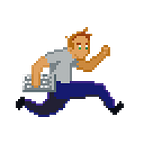Swizzling and invert time. No that’s not a hot new dance move or skate board trick. This article will show how to invert the image we added in part 2 and use that as a way to learn about swizzling. This will get a little technical. If your head starts to spin just do the practice examples.
Missed Part1?
Missed Part 2 — How to add an image
Invert Example Starting Point
As we learned in part 1 that colors and alpha should always be in the 0 to 1 range we can simply invert the colors by changing it to negative and subtracting from one.
Inverting Individual Channels:
texColor.r = 1.0 — texColor.r;
texColor.g = 1.0 — texColor.g;
texColor.b = 1.0 — texColor.b;Inverting Vector 3 — Swizzled
texColor.rgb = vec3(1.0) - texColor.rgb;Inverting Vector 4 — Swizzled
texColor = vec4(1.0) - texColor;
// set alpha back to 1.0
// texColor.a = 1.0;What is Swizzling
In part 1 we learned that we can change each color channel individually via the r, g and b components. A common feature of shader languages like GLSL is the swizzle operators. Those allow selecting multiple components of a vector and change their order. For example, “color.r”, “color.rbg” and “color.brgg” form respectively a scalar, a three components vector and a four components vector. With GLSL, swizzle operators can be both R-values and L-values.
An l-value refers to an object that persists beyond a single expression. An r-value is a temporary value that does not persist beyond the expression that uses it.).
This is called swizzling. You can use x, y, z, or w, referring to the first, second, third, and fourth components, respectively.
There are 3 sets of swizzle masks. You can use xyzw, rgba (for colors), or stpq (for texture coordinates). These three sets have no actual difference. You cannot combine names from different sets in a single swizzle operation. So “.xgp” is not a valid swizzle mask.
Why Swizzle
Swizzle can both make your shader faster, and make your code easier to read.
fragColor = texColor.rgba * vec4(vec3(color1.r), color1.g);This could simply be syntactic shorthand for something like:
fragColor = Vec4(texColor.r, texColor.g, texColor.b, texColor.a)
* Vec4(color1.r, color1.r, color1.r, color1.g);Swizzle masks are essentially free in hardware. Use them where possible.
Challenge
Completed Invert Shader
Links
In part 4 we will learn how to convert an image to gray scale
